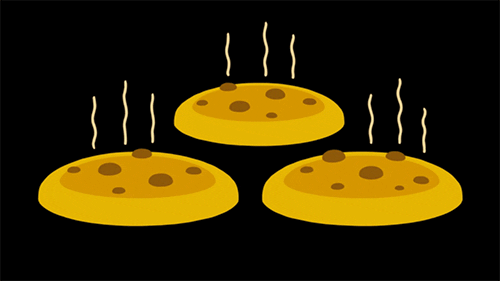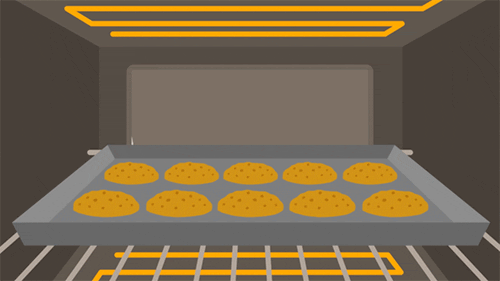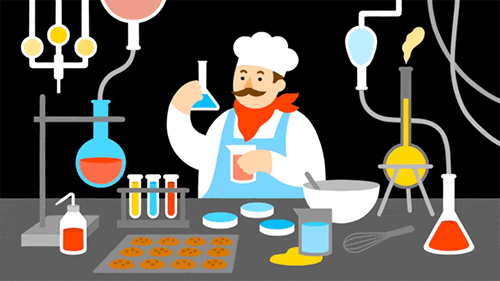5 Cookie Pro Tips From TED-Ed (and Science)
5 Cookie Pro Tips from TED-Ed (and Science)

1. Cookies are for everyone. But everyone has cookie preferences. When you slide that cookie tray into the oven, you’re setting off a series of chemical reactions that transform one substance - dough - into another - cookies! The better you understand ‘Cookie Chemistry’, the better equipped you will be to create the cookies you crave.

2. Lots goes on in that oven, but one of science’s tastiest reactions occurs at 310º. Maillard reactions result when proteins and sugars breakdown and rearrange themselves into ring like structures which reflect light in a way that gives foods their distinctive, rich brown color. As this reaction occurs, it produces a range of flavor and aroma compounds, which also react with each other forming even more complex tastes and smells.

3. The final reaction to take place inside your cookie is caramelization and it occurs at 356º. Caramelization is what happens when sugar molecules breakdown under high heat, forming the sweet, nutty and slightly bitter flavor compounds that define…caramel! So if your recipe calls for a 350º oven - caramelization will never happen.
So, if your ideal cookie is barely browned - 310º will do. But if you want a tanned, caramelized cookie, crank up the heat! Caramelization continues up to 390º degrees.

4. No need to check that oven like a fiend. You don’t even really need a kitchen timer - when you smell the nutty, toasty aromas of the Maillard reaction and caramelization, your cookies are ready!

5. Baking is chemistry, friends! That’s right - PURE. SCIENCE. Check carefully before altering those recipes - chances are some of those ingredients and quantities are there for a reason.
Curious what else happens in that oven? Check out the TED-Ed Lesson The chemistry of cookies - Stephanie Warren
Animation by Augenblick Studios
More Posts from Smparticle2 and Others

Rabies Viruses Reveal Wiring in Transparent Brains
Scientists under the leadership of the University of Bonn have harnessed rabies viruses for assessing the connectivity of nerve cell transplants. Coupled with a green fluorescent protein, the viruses show where replacement cells engrafted into mouse brains have connected to the host neural network.
The research is in Nature Communications. (full open access)








Webb 101: 10 Facts about the James Webb Space Telescope
Did you know…?

1. Our upcoming James Webb Space Telescope will act like a powerful time machine – because it will capture light that’s been traveling across space for as long as 13.5 billion years, when the first stars and galaxies were formed out of the darkness of the early universe.

2. Webb will be able to see infrared light. This is light that is just outside the visible spectrum, and just outside of what we can see with our human eyes.

3. Webb’s unprecedented sensitivity to infrared light will help astronomers to compare the faintest, earliest galaxies to today’s grand spirals and ellipticals, helping us to understand how galaxies assemble over billions of years.

Hubble’s infrared look at the Horsehead Nebula. Credit: NASA/ESA/Hubble Heritage Team
4. Webb will be able to see right through and into massive clouds of dust that are opaque to visible-light observatories like the Hubble Space Telescope. Inside those clouds are where stars and planetary systems are born.

5. In addition to seeing things inside our own solar system, Webb will tell us more about the atmospheres of planets orbiting other stars, and perhaps even find the building blocks of life elsewhere in the universe.

Credit: Northrop Grumman
6. Webb will orbit the Sun a million miles away from Earth, at the place called the second Lagrange point. (L2 is four times further away than the moon!)

7. To preserve Webb’s heat sensitive vision, it has a ‘sunshield’ that’s the size of a tennis court; it gives the telescope the equivalent of SPF protection of 1 million! The sunshield also reduces the temperature between the hot and cold side of the spacecraft by almost 600 degrees Fahrenheit.

8. Webb’s 18-segment primary mirror is over 6 times bigger in area than Hubble’s and will be ~100x more powerful. (How big is it? 6.5 meters in diameter.)

9. Webb’s 18 primary mirror segments can each be individually adjusted to work as one massive mirror. They’re covered with a golf ball’s worth of gold, which optimizes them for reflecting infrared light (the coating is so thin that a human hair is 1,000 times thicker!).

10. Webb will be so sensitive, it could detect the heat signature of a bumblebee at the distance of the moon, and can see details the size of a US penny at the distance of about 40 km.

BONUS! Over 1,200 scientists, engineers and technicians from 14 countries (and more than 27 U.S. states) have taken part in designing and building Webb. The entire project is a joint mission between NASA and the European and Canadian Space Agencies. The telescope part of the observatory was assembled in the world’s largest cleanroom at our Goddard Space Flight Center in Maryland.
Webb is currently being tested at our Johnson Space Flight Center in Houston, TX.

Afterwards, the telescope will travel to Northrop Grumman to be mated with the spacecraft and undergo final testing. Once complete, Webb will be packed up and be transported via boat to its launch site in French Guiana, where a European Space Agency Ariane 5 rocket will take it into space.

Learn more about the James Webb Space Telescope HERE, or follow the mission on Facebook, Twitter and Instagram.
Make sure to follow us on Tumblr for your regular dose of space: http://nasa.tumblr.com.

Green method developed for making artificial spider silk
A team of architects and chemists from the University of Cambridge has designed super-stretchy and strong fibres which are almost entirely composed of water, and could be used to make textiles, sensors and other materials. The fibres, which resemble miniature bungee cords as they can absorb large amounts of energy, are sustainable, non-toxic and can be made at room temperature.
This new method not only improves upon earlier methods of making synthetic spider silk, since it does not require high energy procedures or extensive use of harmful solvents, but it could substantially improve methods of making synthetic fibres of all kinds, since other types of synthetic fibres also rely on high-energy, toxic methods. The results are reported in the journal Proceedings of the National Academy of Sciences.
Spider silk is one of nature’s strongest materials, and scientists have been attempting to mimic its properties for a range of applications, with varying degrees of success. “We have yet to fully recreate the elegance with which spiders spin silk,” said co-author Dr Darshil Shah from Cambridge’s Department of Architecture.
Read more.


“It is the most passionate relationship of the film. It is almost equivalent to that of Scarlett O’hara and Ashley Wilkes and Scarlett and Rhett Butler. Mammy is Scarlett’s true mother. It is Mammy to whom Scarlett goes to for advice, it is Mammy who sees deeply into Scarlett’s emotions and knows everything that’s going on with her. Whereas Scarlett’s biological mother doesn’t understand the emotional turmoil of her daughter. This is an incredible performance, very inflictive, that unfortunately is never getting discussed these days because of the sensitivity we should properly feel.” -Camille Paglia

Black phosphorus holds promise for the future of electronics
Discovered more than 100 years ago, black phosphorus was soon forgotten when there was no apparent use for it. In what may prove to be one of the great comeback stories of electrical engineering, it now stands to play a crucial role in the future of electronic and optoelectronic devices.
With a research team’s recent discovery, the material could possibly replace silicon as the primary material for electronics. The team’s research, led by Fengnian Xia, Yale’s Barton L. Weller Associate Professor in Engineering and Science, is published in the journal Nature Communications April 19.
With silicon as a semiconductor, the quest for ever-smaller electronic devices could soon reach its limit. With a thickness of just a few atomic layers, however, black phosphorus could usher in a new generation of smaller devices, flexible electronics, and faster transistors, say the researchers.
That’s due to two key properties. One is that black phosphorus has a higher mobility than silicon—that is, the speed at which it can carry an electrical charge. The other is that it has a bandgap, which gives a material the ability to act as a switch; it can turn on and off in the presence of an electric field and act as a semiconductor. Graphene, another material that has generated great interest in recent years, has a very high mobility, but it has no bandgap.
Read more.

The winners of the Miss Perfect Posture contest at a chiropractors convention, USA, 1956
via reddit

SoCal, home.

Untitled // Jake Chamseddine

“She has autonomy. She has a strong will. But she can’t move. So in many ways her life is my life. It’s bigger than me, it controls me, and it makes me fight like never before. We spend so much time together that she’s a part of me. She knows how important she is to me. She had childhood cancer. Her heart failed three times. And I was by her side the entire time. I never realized that I could love someone as much as this. She could never hurt me. She could never hurt anyone. We always ask her: ‘Are you angry?’, ‘Are you mad?’ And she always says ‘no.’ She laughs when I laugh. And right now I’m trying not to cry. Because she’ll cry if I cry.” (São Paulo, Brazil)
-
 kittiescatscats liked this · 6 months ago
kittiescatscats liked this · 6 months ago -
 roughfunfiecent liked this · 1 year ago
roughfunfiecent liked this · 1 year ago -
 coffee-math-chamomile liked this · 3 years ago
coffee-math-chamomile liked this · 3 years ago -
 gregpeekatchoo liked this · 4 years ago
gregpeekatchoo liked this · 4 years ago -
 aniascorner reblogged this · 4 years ago
aniascorner reblogged this · 4 years ago -
 lollyase liked this · 5 years ago
lollyase liked this · 5 years ago -
 focuskumm liked this · 5 years ago
focuskumm liked this · 5 years ago -
 aniascorner reblogged this · 6 years ago
aniascorner reblogged this · 6 years ago -
 thelittlestprincess7 reblogged this · 6 years ago
thelittlestprincess7 reblogged this · 6 years ago -
 masterbreadman liked this · 6 years ago
masterbreadman liked this · 6 years ago -
 entropicali liked this · 6 years ago
entropicali liked this · 6 years ago -
 horsesdogscows liked this · 6 years ago
horsesdogscows liked this · 6 years ago -
 oned35-blog liked this · 6 years ago
oned35-blog liked this · 6 years ago -
 gothamcitypoprocks liked this · 6 years ago
gothamcitypoprocks liked this · 6 years ago -
 jsgilmaya-blog liked this · 6 years ago
jsgilmaya-blog liked this · 6 years ago -
 mariannevibart reblogged this · 6 years ago
mariannevibart reblogged this · 6 years ago -
 lyttlebits liked this · 6 years ago
lyttlebits liked this · 6 years ago -
 b1ee liked this · 6 years ago
b1ee liked this · 6 years ago -
 yosupkinkle liked this · 6 years ago
yosupkinkle liked this · 6 years ago -
 plumbuck liked this · 6 years ago
plumbuck liked this · 6 years ago -
 vivalafaerie reblogged this · 6 years ago
vivalafaerie reblogged this · 6 years ago